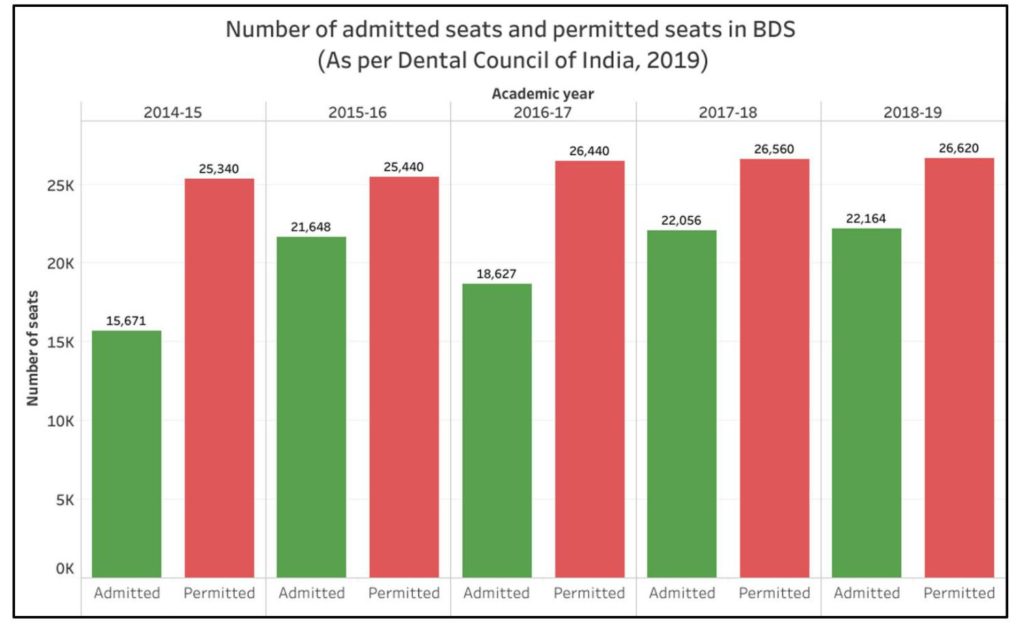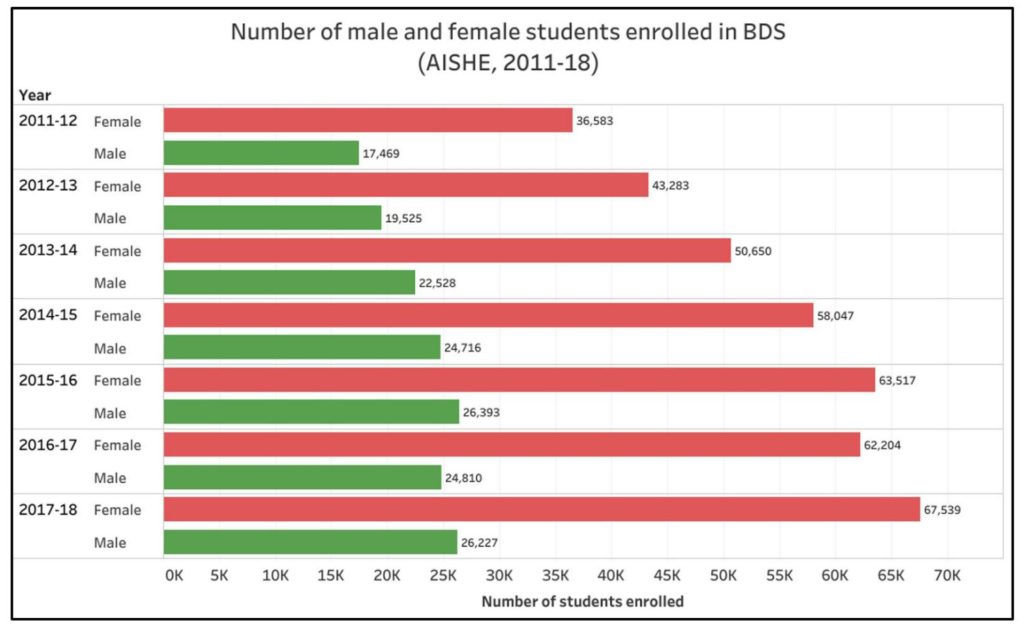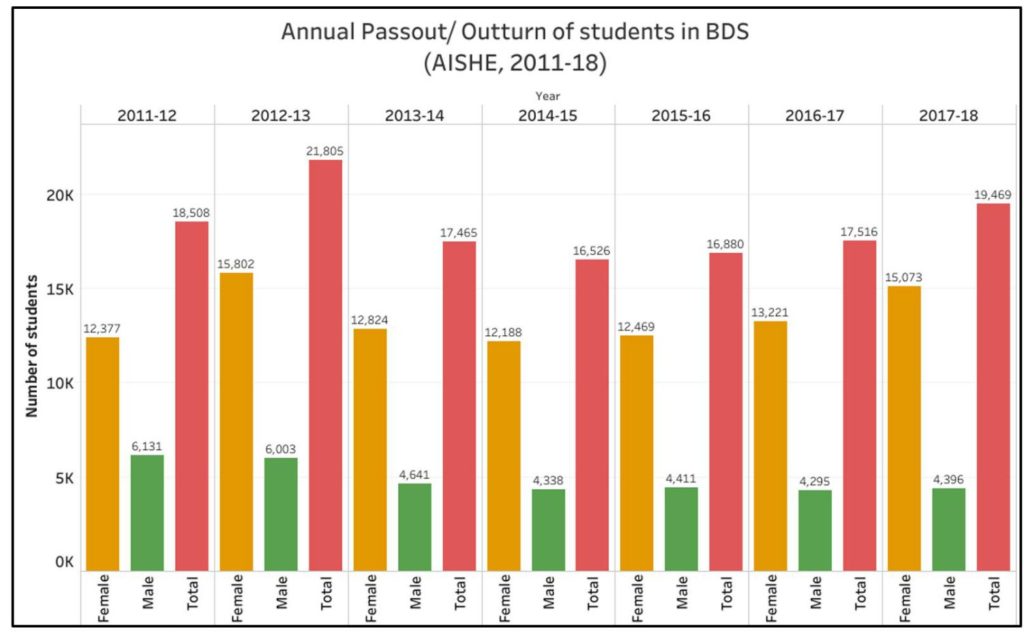[orc]Unlike in the case of Engineering & Pharmacy education where females accounted for 20-35% of the enrolments, they make up for 70% of the enrolled students in the case of BDS.
There have been academic studies dating back to 2015 that talk about over-supply of Dentists and the increasing unemployment among Dental graduates. But the numbers do not indicate any decrease in admissions. The numbers related to the Bachelor of Dental Surgery (BDS) course indicate that after a dip in 2016-17, the admissions have increased in the last two years.
Dental Council of India (DCI) is a statutory body incorporated under The Dentists Act, 1948 to regulate dental education and the profession throughout the country. As per their website, in July 2019, there are 313 colleges for the BDS course and 259 colleges for the Master’s degree or MDS.
Number of Admissions to BDS has increased in the last two years
According to the statistics available on the DCI website, the number of permitted seats has only increased by about 1280 in the 5-year period from 2013-14 to 2018-19.

Data also suggests that number of admissions to the BDS course increased by a whopping 38.1% from 2014-15 to 2015-16. This 30% increase is significant considering that the number of permitted seats increased by only 100 (or 0.4%) during this period.
This was followed by a drop of nearly 14% in the admissions in 2016-17 though the number of permitted seats increased by 1000. But after this up & down cycle, the number of admissions seem to have stabilized at around 22,000. In both 2017-18 and 2018-19, the number of BDS admissions crossed the 22,000 figure and more than 83% of the permitted seats have been filled in both years. For the academic year 2019-20, only 73 BDS seats have been added. From the data, it is also clear that the number of BDS seats have been increasing annually in the last 5 years, unlike in the case of engineering or management courses.
89% of the BDS seats are in Private Colleges
In response to a question in the Lok Sabha from March 2018, the government presented figures related to the number of seats of MBBS and BDS seats in India. Only 10.8% of the seats are in government colleges and the remaining 89.2% are in the private colleges. According to the presented data, in 2017-18, Karnataka had the largest number of seats for BDS with 3520 seats. Of this, 160 are government seats and the rest 3360 seats are private and hence, it has the maximum number of private seats. Following Karnataka is Maharashtra with 3510 seats- 260 government and 3250 private. Gujarat, with a total of 1240 seats has the highest number of government seats, i.e., 400 government seats. Andaman and Nicobar Islands, Meghalaya, Sikkim and Tripura do not have even a single college offering BDS and hence no seats.

Females constitute 70 % of the total students enrolled in BDS
The All India Survey on Higher Education (AISHE) revealed that the proportion of female students pursuing this course is much higher than their male counterparts and is increasing every year. Females constitute 70% of the total students enrolled in BDS- unlike in the case of other courses such as engineering and pharmacy where the proportion of females is low- around 25% and 40% respectively. In the AISHE , the number of students enrolled in a course refers to the total number of students who are on roll in the program (cumulative of all years) as on 30th September of that academic year. Hence the numbers in the chart below relate to the cumulative number of students enrolled in the BDS course as of that year and not admissions of that particular year.
The numbers clearly indicate that the number of females joining BDS has been increasing year after year. In 2011-12, females accounted for 67.7% of the enrolments and this has increased to 72% in 2017-18.

The total number of students passing out has increased by 17.8% in 4 years
The data of the number of students who pass out annually is also available from the AISHE. The total number of students passing out has increased by 17.8% in 2017-18 compared to 2014-15. Data also suggests that the proportion of females passing out is increasing while that of male students is coming down over the years. From 66.8% in 2011-12, the proportion of females passing out every year has increased to 77.4% in 2017-18. This could also be due to the increasing proportion of females who enrol for the BDS course.

Does India have an over-supply of Dentists?
India, currently has 2,71,798 registered dentists for a population of 1.33 billion as of July 2019, as per the DCI website. In other words, there is one dentist for approximately 4,927 Indians. As per the recommendation of WHO, the ideal dentist population ratio is 1: 7500. Though these numbers may suggest that the oral healthcare in India is well covered & developed, a closer look this reveals that the distribution of dentists is not uniform throughout urban and rural areas. There is inequity in dentist distribution even among the states.
A WHO study of 2016 revealed that only 20.8% of the total dentists were available in rural areas. Thus, only one dentist is available for approximately 14,735 people in rural India- almost half of the recommended ratio. In addition, there is uneven distribution of colleges in the country with some states having no access to dental education.
About the AISHE Methodology: According to the AISHE data, the number of students enrolled in a course refers to the total number of students who are on roll in the program (cumulative of all years) as on 30th September of that academic year.
Featured Image:Bachelor of Dental Surgery Seats


